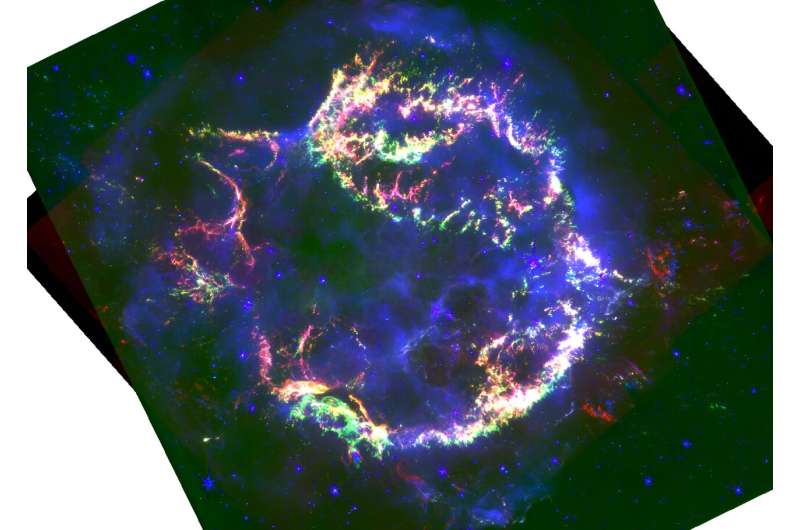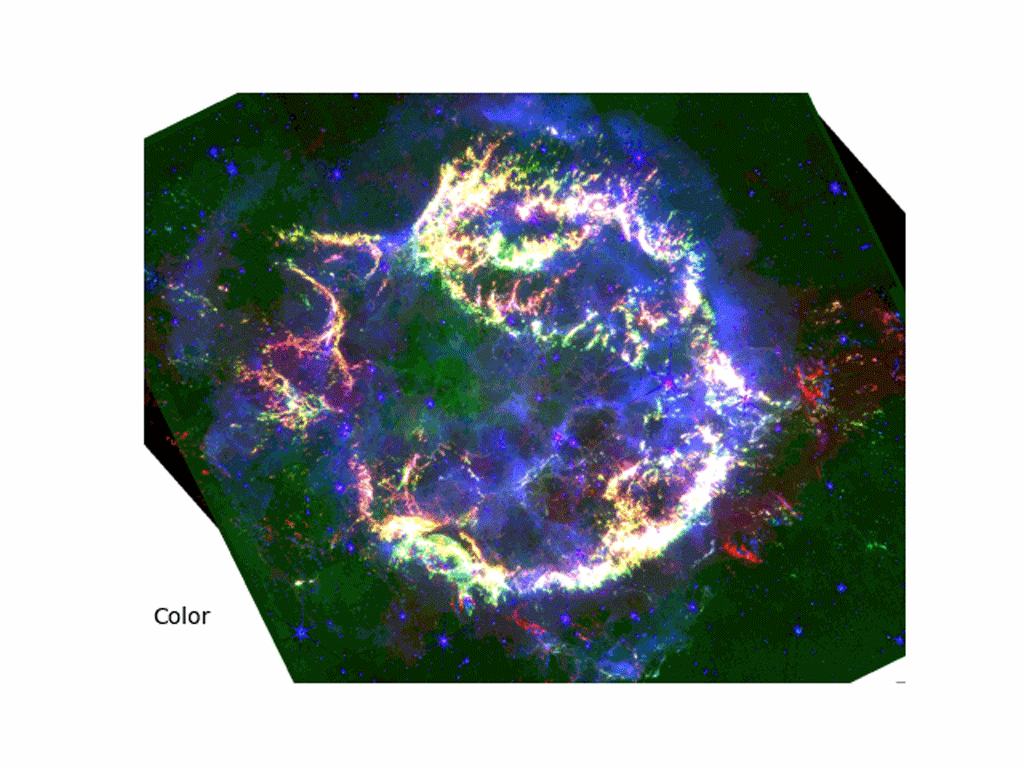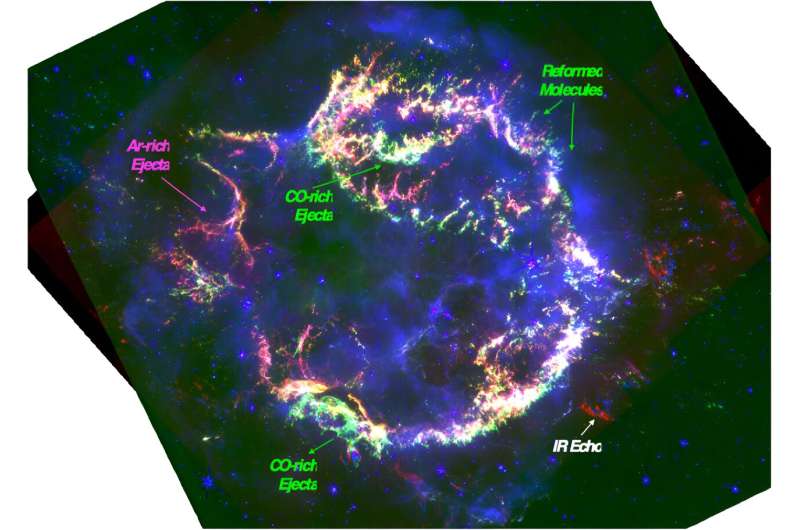
Three-color JWST image of Cassiopeia A, contrasting carbon monoxide (CO in green) and argon emission (in red) and synchrotron emission (in blue). The images show that there is more CO gas in the outer layers than argon gas, which means that after the reverse shock, CO molecules are formed again. Retrieved from SETI Institute
The SETI Institute has announced the latest findings from the James Webb Space Telescope (JWST) of the remnants of the supernova, Cassiopeia A (Cas A). These observations of the youngest known core collapse supernova in the Milky Way provide insight into the conditions that lead to the formation and annihilation of molecules and dust within ejected supernovae.
The study findings will change our understanding of dust formation in the early universe in galaxies detected by JWST 300 million years after the Big Bang. Researchers consider supernovae, such as those that formed Cas A, to be an important source of the dust found in distant, high-red galaxies. These new insights challenge the belief that dust mainly originated from intermediate-mass stars on the asymptotic giant branch (AGB) in present-day galaxies.
“It is interesting to see how bright the carbon monoxide emission is detected in JWST NIR imaging and spectroscopy, which shows several dozen sinusoidal patterns of underlying CO vibrational lines,” said Dr. Geohgi Ro, a research scientist at the SETI Institute who led the study. . . . . “The maps look like they’re artificially created.”
Key findings include:
- Molecular CO formation: The data show more CO gas in the outer layers than argon gas, which means that CO molecules are regenerated after the reverse shock. These data are important for understanding how cooling and dust formation occur after a supernova explosion. The images indicate that the CO molecules were reformed behind the shock and may have preserved the dust in the extract.
- Microspectroscopy: NIRSpec-IFU spectra of two regions of interest in Cas A show differences in how the elements are formed. Both regions have strong CO gas signals and show various ionizable elements such as argon, silicon, calcium and magnesium. CO baselines are several dozen sinusoidal patterns of CO rovibrational baselines underlain as a continuum due to the high velocity of CO molecules.
- Understanding Temperature: The study shows that the temperature is about 1080 K, based on CO emissions. This helps us understand how highly ionized dust, molecules and gas interact in supernovae. However, the authors also find vibration lines in high spin lines (J=90), whose features appear in the 4.3-4.4 micron range. These lines indicate the presence of hotter (4800 K) temperature components, indicating the formation and reforming of CO at the same time. CO from higher rotational levels is seen for the first time in Cas A with the new JWST spectroscopy.
- Supernovae like Cass A, located 11,000 light-years away, are the explosions that occur when a high-mass star reaches the end of its life about 350 years ago. Called a nuclear collapse supernova, the star’s interior collapses inward due to gravity as the nuclear fuel that powered the star depletes. The return of this collapse would blow the outer shell of the star into space in an explosion that could outshine an entire galaxy.

Retrieved from SETI Institute
“To see such hot CO in a young supernova remnant is really exciting and indicates that CO formation is still happening thousands of years after the explosion,” said Chris Ashall, an assistant professor at Virginia Tech.
“Combining such impressive datasets with previous JWST observations of supernovae allows us to understand molecule pathways and dust formation in a way that wasn’t possible before.”
advanced imaging and spectroscopy
The observations used JWST’s Near Infrared Camera (NIRCam) and Mid-Infrared Instrument (MIRI), along with Near Infrared Spectrographic Precision Spectroscopy (NIRSpec)-Integrated Field Units (IFU). The team mapped complex structures of synchrotron radiation (light emitted when charged particles, such as electrons, are accelerated to high speeds in strong magnetic fields), argon-rich extracts and carbon monoxide (CO) molecules within Cas A. Images show ultra-fine patterns and The complexity of the shells, holes and strands, highlighting how robust JWST is.

Retrieved from SETI Institute
Seong Hyun Park, a graduate student at Seoul National University in South Korea, with Ro.
New observations highlight complex molecular formation and annihilation processes and competition for supernova debris. While not directly causing dust formation, CO molecules are important indicators of cooling and chemical processes that ultimately lead to dust condensation.
While this study offers new perspectives, the debate continues about the extent to which supernovae contribute to dust formation in the early Universe. Researchers will continue to explore these phenomena with future observations and studies to unravel the mysteries of cosmic dust and molecular formation.
Findings this week in. Journal of Astrophysical Letters. . . .
More information:
J. Rho et al, Shockingly Tropical Molecular Properties of Carbon Monoxide in the Debris of Supernova Cassiopeia A Revealed by JWST, Journal of Astrophysical Letters (2024). doi: 10.3847/2041-8213/ad5186
Provided by the SETI Institute
translate: Webb unveils stunning ejecta and CO compositions from the young supernova Cassiopeia A (2024, July 15) which will be released on July 16, 2024 at https://phys.org/news/2024-07-webb-unveils-stunning-ejecta- cassiopeia.html Retrieved
This document is subject to copyright. Except for any fair dealing for the purpose of research or private investigation, no part may be reproduced without written permission. The content is provided for informational purposes only.
#Webb #unveils #amazing #composition #ejecta #young #supernova #Cassiopeia #Ada